CHEVROLET CAMARO 1993 Repair Manual
Manufacturer: CHEVROLET, Model Year: 1993, Model line: CAMARO, Model: CHEVROLET CAMARO 1993Pages: 358, PDF Size: 15.6 MB
Page 61 of 358
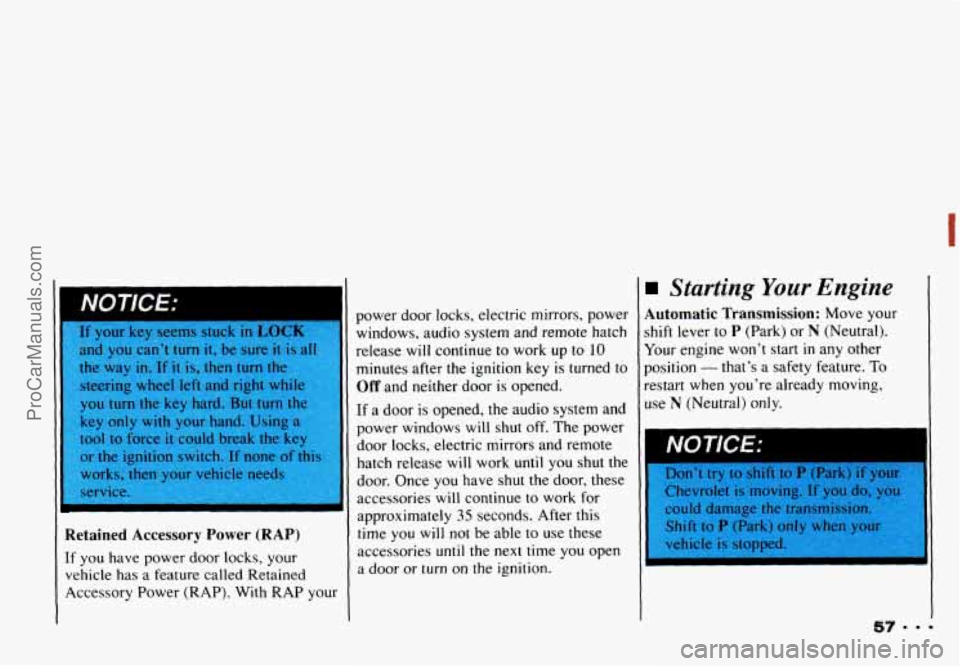
I
rn
1
I
I
NOTICE:
I. If your key seems stuck in LOCK 1
and you can’t turn it, be sure it is all 5
the way in. If it is, then turn the
steering wheel left and right whil
you turn the key hard. But turn
tt
key only with your hand. Usir
tool
to force it could break the key
or
the ignition switch. If none of thi:
works,
then your vehicle nvAr
service.
T
i
ietained Accessory Power (RAP)
f you have power door locks, your
lehicle
has a feature called Retained
kcessory Power (RAP). With RAP your power
door locks, electric mirrors, power
windows, audio system and remote hatch
release will continue
to work up to 10
minutes after the ignition key is turned to
Off and neither door is opened.
If a door is opened, the audio system and
power windows will shut off. The power
door locks, electric mirrors and remote
hatch release will work
until you shut the
door. Once you have shut the
door, these
accessories
will continue to work for
approximately
35 seconds. After this
time you
will not be able to use these
accessories
until the next time you open
a
door or turn on the ignilion.
Starting Your Engine
Automatic Transmission: Move your
shift lever to P (Park) or N (Neutral).
Your engine won’t start
in any other
position
- that’s a safety feature. To
restart when you’re already moving,
use
N (Neutral) only.
NOTICE: I
Don‘t try to shilt to P (Park) if your
Chevrolet is moving.
If you do, vou
could damage the transmission,
Shift
to P (Park) o
V
ProCarManuals.com
Page 62 of 358
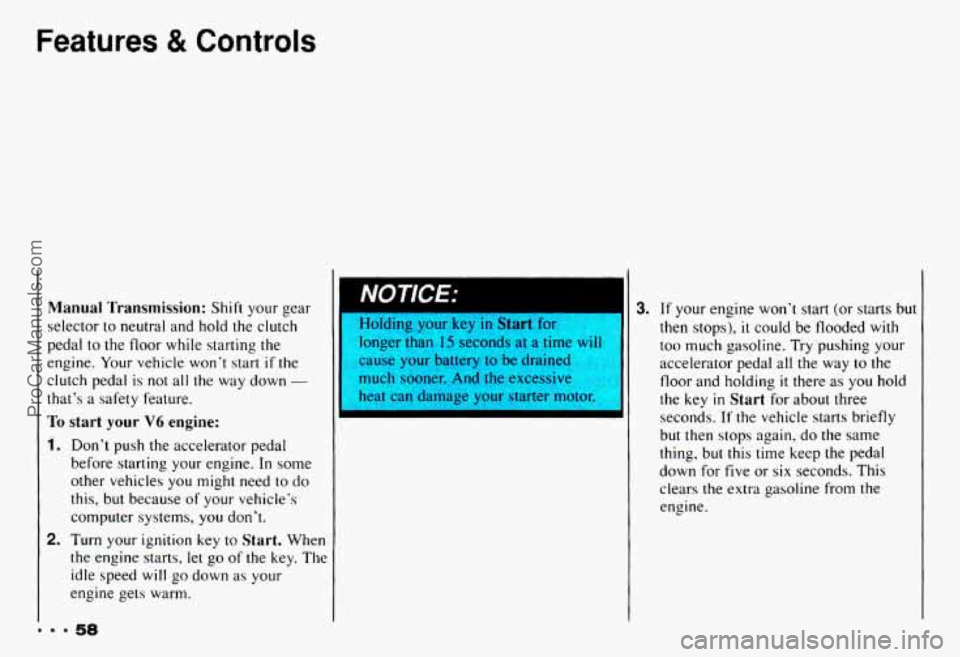
Features & Controls
Manual Transmission: Shift your gear
selector to neutral and hold the clutch
pedal
to the floor while starting the
engine. Your vehicle won’t start if the
clutch pedal
is not all the way down -
that’s a safety feature.
To start your V6 engine:
1. Don’t push the accelerator pedal
before starting your engine.
In some
other vehicles
you might need to do
this, but because of your vehicle’s
computer systems,
you don’t.
2. Turn your ignition key
to Start. When
the engine starts, let go
of the key. The
idle speed
will go down as your
engine gets warm.
NOTICE: 3. If your engine won’t start (or starts but
then stops),
it could be flooded with
too much gasoline. Try pushing your
accelerator pedal all the way
to the
floor and holding
it there as you hold
the
key in Start for about three
seconds.
If the vehicle starts briefly
but then stops again, do the same
thing, but
this time keep the pedal
down for five
or six seconds. This
clears the extra gasoline from the engine.
ProCarManuals.com
Page 63 of 358
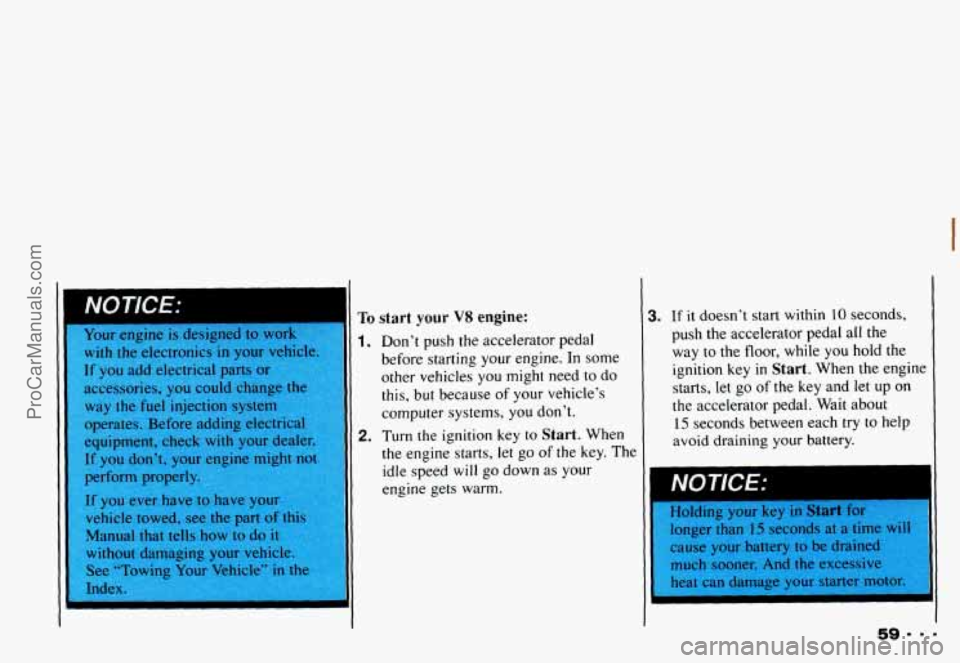
1.
2.
Don't push the accelerator pedal
before starting your engine.
In some
other vehicles you might need to do
this, but because
of your vehicle's
computer systems, you don't.
Turn the ignition key
to Start. When
the engine starts,
let go of the key. The
idle speed
will go down as your
engine gets warm.
3. If it doesn't start within 10 seconds,
push the accelerator pedal all the
way to the
floor, while you hold the
ignition key
in Start. When the engine
starts, let go
of the key and let up on
the accelerator pedal. Wait about
15 seconds between each try to help
avoid draining your battery.
NOTICE:
Holding your kev in Start for
II longer than 15 siconds at a time will
cause your battery
to be drained
much sooner. And the excessive beat can damage your starter
motor. _,~~___ ~- . x ,~~ "~~~ ..,." _... . .~ ,........,.,.. . I
ProCarManuals.com
Page 64 of 358
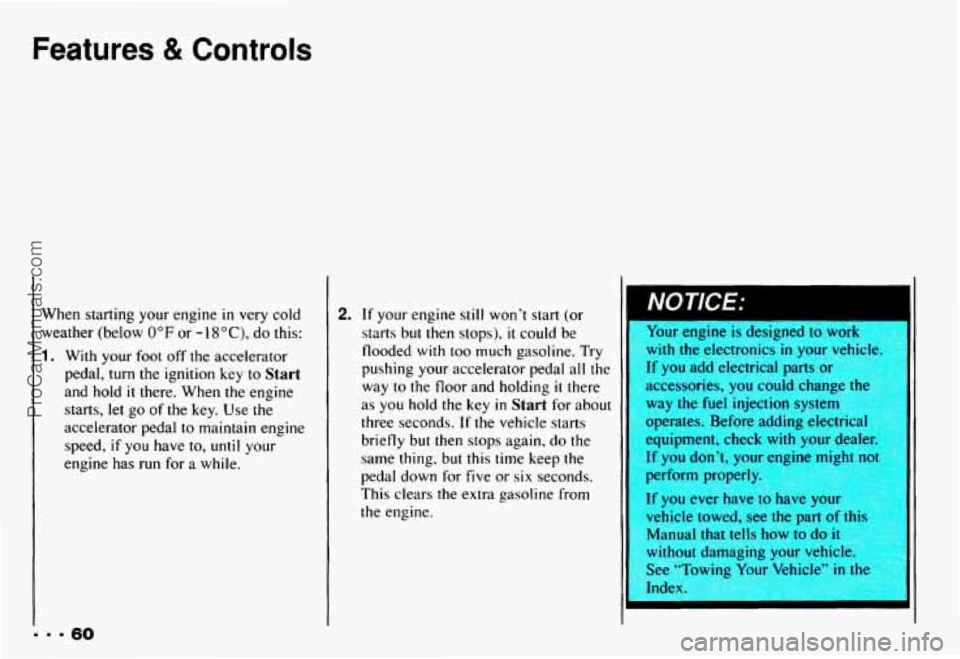
Features 8t Controls
When starting your engine in very cold
weather (below
0°F or - I SOC), do this:
1. With your foot off the accelerator
pedal,
turn the ignition key to Start
and hold it there. When the engine
starts, let go of the key. Use the
accelerator pedal to maintain engine
speed,
if you have to, until your
engine has run for
a while.
2. If your engine still won’t start (or
starts
but then stops), it could be
flooded
with too much gasoline. Try
pushing your accelerator pedal all the
way to the floor and holding
it there
as you hold the key in Start for about
three seconds.
If the vehicle starts
briefly but then stops again, do the
same thing, but this time keep the
pedal down for five or
six seconds.
This clears the extra gasoline from
the engine.
NOTICE:
1 Your engine is designed to work
with the electronics in your vehicle.
If you add electrical parts or
accessories, you could change
th
way the fuel injection system
operates. Before adding electrlcal
equipment, check with your dealer.
II
If you don’t, your engine might not
perform properly.
If you ever have
to have your
vehicle towed, see the part
of thi
Manual that tells how to do it
without damaging your vehicle.
See “Towing Your Vehicle’’
in th
Index
I I
ProCarManuals.com
Page 65 of 358
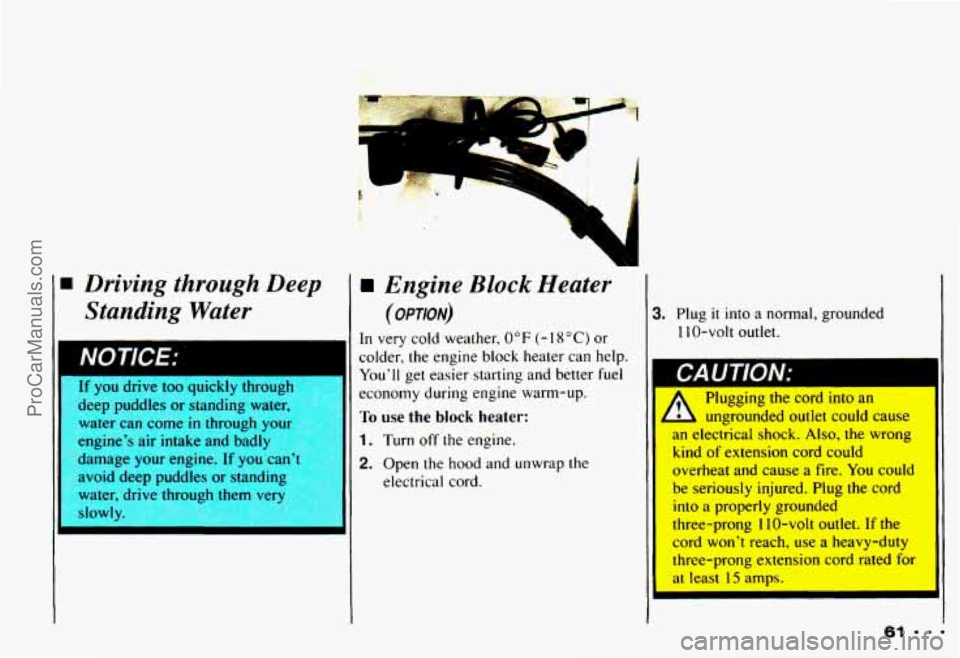
Driving through Deep Standing
Water
NOTiCE:
[f you drive too quickly throul
deep puddles or standing wt :r,
water can come
in through your
engine’s air intake and badly
damage your engine.
If you can’t
avoid deep puddle< nr standing
water, drive throul them very
slowly
Engine Block Heater
(OPTION)
In very cold weather, 0 OF (- 1 8 “C) or
colder, the engine block heater can help.
You’ll get easier starting and better fuel
economy during engine warm-up.
To use the block heater:
1. Turn off the engine.
2. Open the hood and unwrap the
electrical cord.
3. Plug it into a normal, grounded
1 10-volt outlet.
CA UTiON:
A
Plugging the cord into an
ungrounded outlet could cause
I
an electrical shock. Also, the wrong
kind of extension cord could
overheat and cause a fire. You could
be seriously injured. Plug the cord into a properly grounded
three-prong
1 10-volt outlet. If the
cord won’t reach, use a heavy-duty
three-prong extension cord rated
for
at least 15 amps.
ProCarManuals.com
Page 66 of 358
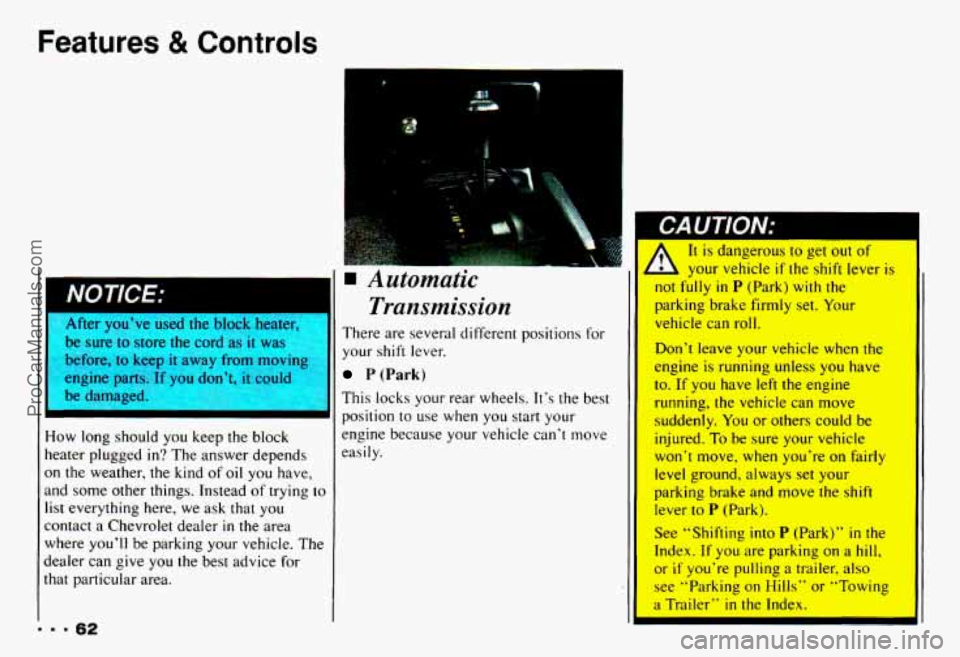
Features & Controls
I NOTICE:
I HTI~~ you-ve usea me DIOCK neater, I- sure to store the cord as it was
,-fore, to keep
it aw-f from movin
engine parts.
If you h’t ; $&add ,$a;!$$$,.
be damaged.
I
, . ,Q i ,,<.> . , t!!! h,~
I
How long should you keep the block
heater plugged in? The answer depends
on the weather, the kind of oil you have,
and some other things. Instead of trying to
list everything here, we ask
that you
contact
a Chevrolet dealer in the area
where you’ll be parking your vehicle. The
dealer can give
you the best advice for
that particular area,
... 62
Automatic
Transmission
There are several different positions for
your shift lever.
P (Park)
This locks your rear wheels. It’s the best
position to use when you start your
engine because your vehicle can’t move
easily.
It is dangerous to get out of
your vehicle
if rhe shift lever is
not fully in P (Park) with the
parking brake
firmly set. Your
vehicle can roll.
Don’t leave your vehicle when the
engine
is running unless you have
to. If you have left the engine
running, the vehicle can move
suddenly.
You or others could be
injured. To be sure your vehicle
won’t move, when you’re on fairly
level ground, always set your
parking brake and move the shift lever to
P (Park).
See “Shifting into
P (Park)” in the
Index.
If you are parking on a hill,
or if you’re pulling a trailer, also
see “Parking on Hills” or “Towing
a Trailer” in the Index.
ProCarManuals.com
Page 67 of 358
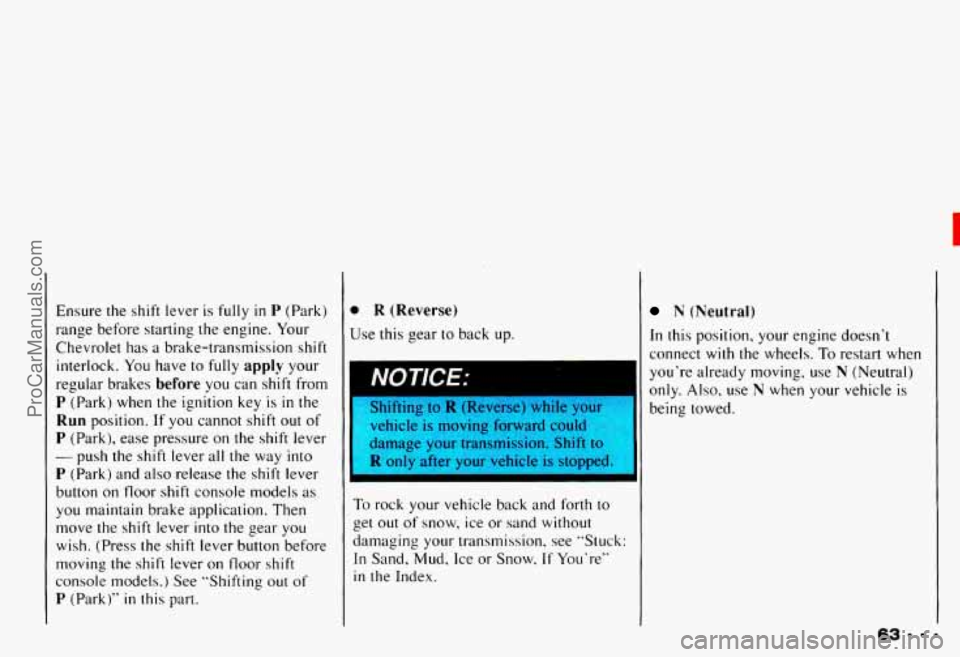
I
Ensure the shift lever is fully in P (Park)
range before starting the engine. Your
Chevrolet has a brake-transmission shift
interlock. You have
to fully apply your
regular brakes
before you can shift from
P (Park) when the ignition key is in the
0 R (Reverse)
Use this gear to back up.
11 NOTICE:
I Shifting to K (Reverse) while your
Run position. If you cannot shift out of vehicle is moving forward could
P (Park), ease pressure on the shift lever damage your transmission. Shift to
- push the shift lever all the way into R only after your vehicle is stopped.
P (Park) and also release the shift lever
button on floor shift console models as
you maintain brake application. Then
move the shift lever into the gear you
wish. (Press the shift lever button before
moving
the shift lever on tloor shift
console models.) See "Shifting out of
P (Park)" in this part.
To rock your vehicle back and forth to
damaging your transmission, see "Stuck:
In Sand, Mud, Ice or Snow, If You're"
in the Index.
L get out of snow, ice or sand without
N (Neutral)
In this position, your engine doesn't
connect
with the wheels. To restart when
you're already moving, use
N (Neutral)
only.
Also, use N when your vehicle is
being towed.
639 9
ProCarManuals.com
Page 68 of 358
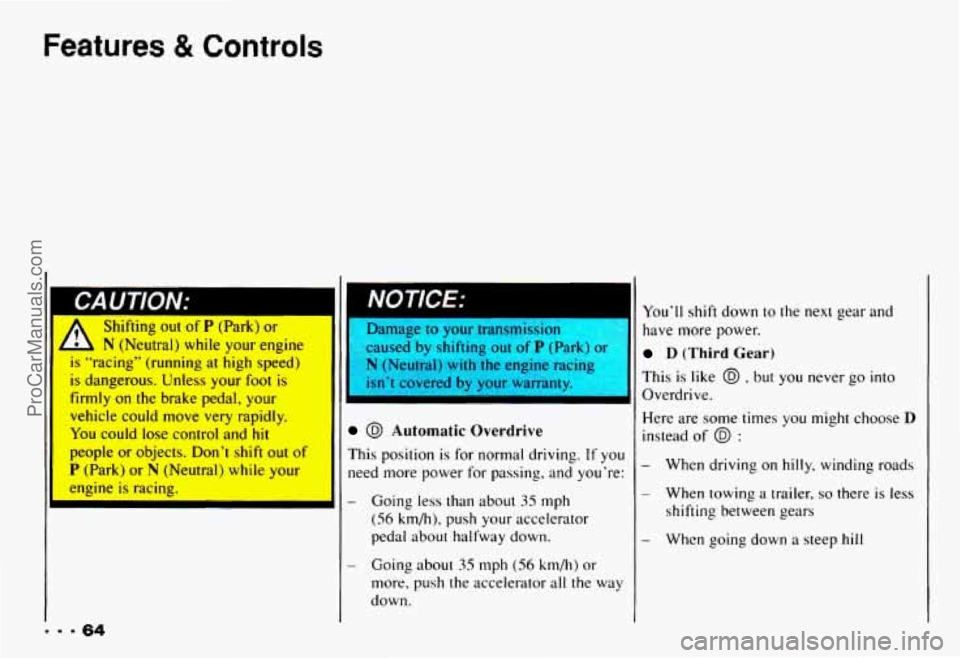
Features & Controls
.
Shifting out of Y (Park) or
N (Neutral) while your engine
13 “racing” (running at high speed)
is dangerous. Unless your foot is
firmly on the brake pedal, your
vehicle could move very rapidly.
You could lose control and
hit
people or objects. Don’t shift out of
P (Park) or N (Neutral) while your
engine
is racing.
I I Damage to your transmission
caused by shifting out of P (Park) o
N (Neutral) with the engine racin;
isn’t covered by your warranty. ~ I
@ Automatic Overdrive
This position is for normal driving. If you
need more power for passing, md you’re:
- Going less than about 35 mph
(56 km/h), push your accelerator You’ll
shift down
to the next gear and
have more power.
D (Third Gear)
This is like @I , but you never go into
Overdrive.
Here are some times you might choose
D
instead of @ :
- When driving on hilly, winding roads
- When towing a trailer. so there is less
shifting between gears
pedal abou; halfway down.
I- When going down a steep hill
- Going about 35 mph (56 km/h) or
more, push the accelerator all the way
down.
ProCarManuals.com
Page 69 of 358
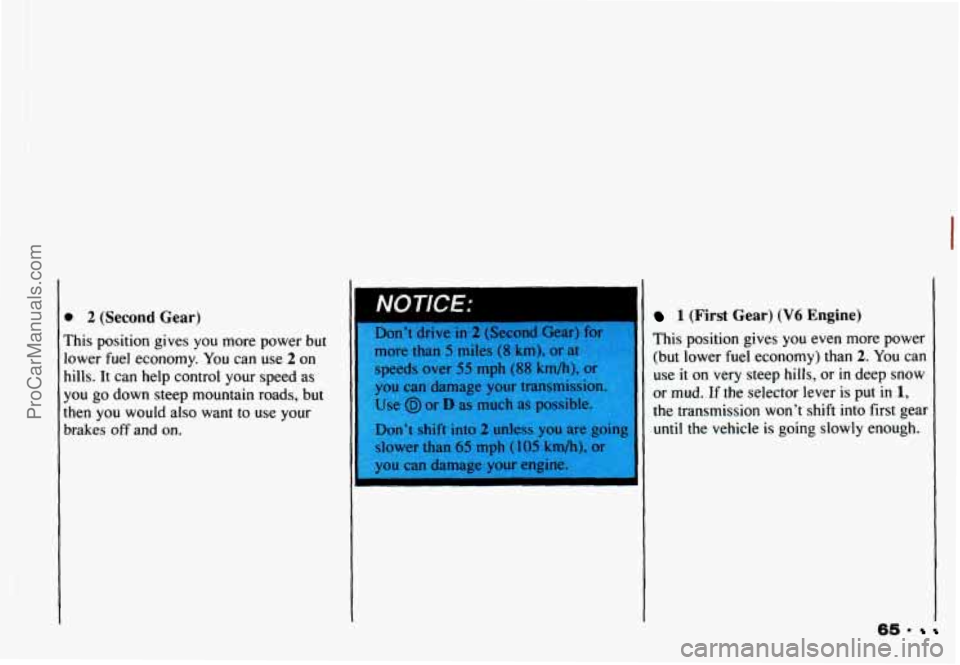
D 2 (Second Gear)
rhis position gives you more power but
.ower fuel economy. You can use 2 on
lills. It can help control your speed as
you go down steep mountain roads, but
:hen you would also want to use your
xakes
off and on.
NOTICE:
Don't drive in 2 (Second Gear)
more than 5 miles (8 km), or at
speeds over
55 mph (88 kmh)
you can damage your transmissi
Use @ or D as much as possible.
Don't
shift into 2 unless you are golng
slower than 65 mph ( 105 km/h), 1
you can damage your engine.
1 (First Gear) (V6 Engine)
This position gives you even more power
(but lower fuel economy) than
2. You can
use
it on very steep hills, or in deep snow
or mud. If the selector lever is put
in 1,
the transmission won't shift into first gear
until the vehicle is going slowly enough.
65.
ProCarManuals.com
Page 70 of 358
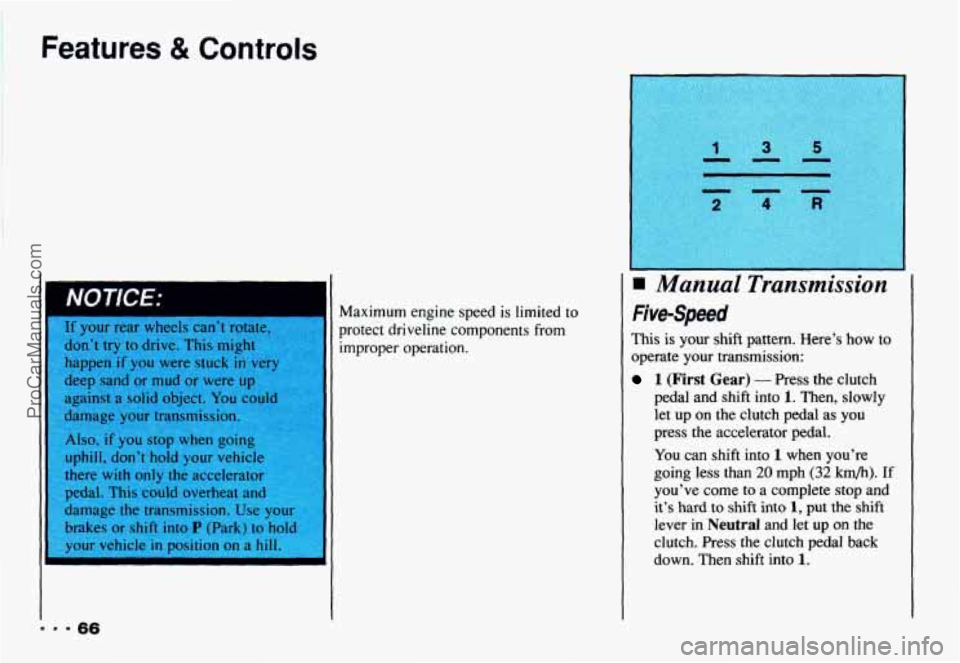
Features & Controls
r
If your rear wheels can’t rotat
don’t try to drive.
This might
happen if you were stuck
in v
deep sand or mud or were up
, , against a solid object. You
damage your transmission
Also, if you stop when goi
uphill, don’t hold your vehi
there
with only the accelerat
pedal. This could overheat an
damage the transmission.
Use your
brakes or shift into
P (Park) to hold
9.966
Maximum engine speed is limited to
protect driveline components from
improper operation.
Manual Transmission
Five-Speed
This is your shift pattern. Here’s how to
operate your transmission:
1 (First Gear) - Press the clutch
pedal and shift into
1. Then, slowly
let up on the clutch pedal as you
press the accelerator pedal.
You can shift into
1 when you’re
going less than
20 mph (32 km/h). If
you’ve come to a complete stop and
it’s hard to shift into
1, put the shift
lever in
Neutral and let up on the
clutch.
Press the clutch pedal back
down. Then shift into
1.
ProCarManuals.com